Tools for Brushing

Lopping shears allow branches to be cut
cleanly and flush with tree trunks.
Lopping and pruning shears are similar in design and use, although lopping shears have longer handles to improve reach, and gear drives to increase leverage for thicker stems. Cutting edges vary, but generally one blade binds and cuts a stem against an anvil or beveled hook. We recommend the hook and blade shear for overhead cuts because the curved blades transfer the weight of the shears to the limb. Quality shears have rust- resistant steel blades. Handles are wood or aluminum. Handles range from 26 to 36 inches long. Limbs up to 3 inches can be cut with shears.

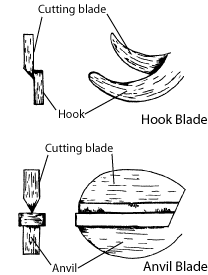
Hook and anvil cutting blades.

Lopping shears
Transport shears with the blades closed. Grip the tool on one handle just behind the blade and carry it by your side. Clean moisture and sap from blades after use. Keep metal parts lightly oiled to prevent rust. Frequently check nuts and bolts for tightness, and always carry replacements in the field.
To sharpen, spread the handles apart, resting one or both ends on a flat surface. Use a mill bastard file on the cutting blade only; neither hooks nor anvils are sharpened. Maintain factory bevels while filing toward the cutting edge. Use a whetstone to remove the wire edge.

Sharpening lopping shears.

Heavy-duty lopping shears are ideal for the forester.
They have ash handles,
make a 3-inch diameter cut,
and are 37½ inches long. Weight is 5½
pounds.

"Forester" heavy-duty brush cutters make a 2-inch
diameter
cut for heavy-duty jobs—hardwood,
deadwood,
branches, or brush.
The rugged
steel
construction
is even strong enough to
dehorn
and
clip
cattle.
Both blades cut to reduce
bark
damage. The shears
are 27
to
34
inches
long and weigh 4 to 8 pounds.

Snap-cut professional lopping shears make a 1¾-inch
diameter cut.
They
are a gear-driven lopping shear
with
tremendous cutting
power—10
pounds force
applied to the handles gives 300 pounds
of
cutting power.
The shears are 30 inches long
and weigh 5½ lbs.

True-Temper lopping shears give a 1½-inch
diameter
cut.
The tubular
steel handles
provide extra
strength and the rubber
cushion
grips absorb
shocks. These
are used
by
biologists
to remove
deer
jawbones.
The
shears
are 26 inches
long and weigh
2¼ pounds.

The Hi-Tork lopper makes a 1½-inch diameter
cut.
It is designed for
hardwood, frozen wood,
brush
, and deadwood.
The shears are 27
inches
long
and weigh 3 pounds.

Point-cut pruners make a 1¼-inch diameter
cut.
The blades open wide
to cut suckers or
sprouts
at
blade point.
Weight is 3 pounds.
Bank blades and bush hooks are designed specifically for cutting through thickets of heavy brush or saplings. Their long handles and heavy heads will add momentum to the force of your swing, but their curved blades also pose extra safety hazards. Always maintain a firm grip with both hands on the handle. Cut with a slicing rather than a hacking motion. Remember that bank blades have cutting edges on both edges of the blade. Stay clear of other workers. Be aware of the increased possibility of glancing blows, and always control the swing to avoid cuts to the legs or feet. Wear shin guards when operating these tools. Blades are available in 12- to 16-inch lengths. Handles are 36 inches or 40 inches long. The tool weighs from 3½ to 5 pounds.

Carry bank blades and bush hooks with the head forward like a shovel. Grip the handle near the head and hold the hook away from the body and down.
Sharpen bank blades and bush hooks with a mill bastard file and finish with a whetstone. Always wear your gloves and use a file guard. Stroke along the straight edges of the blades and swing the stone or file in an arc to maintain the factory edge bevel on curved sections.

Sharpening a bush hook.
Examples:

Bush hooks are used for clearing work that is too
heavy for a
scythe
and not suited for an ax. They
are
available with single-edged,
eye-and-strap
blade,
or double-edged, ax-eye blade type.
They
have hickory handles
12 to 36 inches long and
weigh 2 to 4½ pounds.
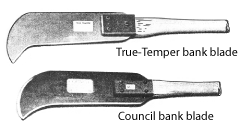
Bank blades are used for clearing thick undergrowth
and brush.
The blade
is sharpened on both sides.
Blade
lengths may be 12 or 16 inches.
Hickory
handles are available in 36 or 42 inches.
These tools weigh 1 to 5½
pounds.
Clearing Knives and Swedish Brush (Sandvik) Axes
These clearing tools work well in brushy thickets or when clearing in rocky or confined areas. Clearing knives look like small, short, brush hooks, so use, carry, and sharpen them accordingly. Handle length will determine if the tool is operated one- or two-handed. Use and carry a short-handled clearing knife like a machete.
![]()
Brush axes have different blades than clearing knives. The replaceable Swedish steel blade has a 5½-inch cutting edge. The ax has a 27-inch long handle. It weighs about 2½ pounds. They have removable blades held in a C-shaped frame under tension. Tension may weaken and cause blades to pop out. Bend the frame outward slightly to increase tension. The blade can be removed for sharpening. Avoid overheating the blade and losing the temper. Replace badly damaged blades.
![]()
A Swedish brush ax cuts small saplings and
brush easily, safely.
The
replaceable Swedish
steel blade has a 5½-inch cutting edge.
The
hickory
handle is 27 inches long overall,
and weighs 2½ pounds.

Sharpening the brush ax.
Machetes and Woodsman's Pals are used to clear weeds, brush, and small trees along a trail. Machetes became commonly used in Forest Service work after World War II when surplus knives were used extensively for brushing. Machetes have blades from 17 to 24 inches long and weigh up to 2 pounds. The Woodsman's Pal is shorter and sturdier than the machete and includes a cutting hook and a knuckle guard. It is used for cutting, chopping, digging, hacking, and pulling. It is 16 inches long and weighs about 1½ pounds.
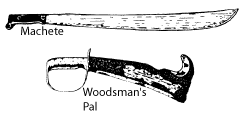
Because these are single-grip tools, a worker must always maintain a firm grip while swinging. Also, be aware of the location of fellow workers. The hook on the end of the Woodsman's Pal can slip as it is pulled toward you and cut legs or hands, or it may strike the back of an operator's head on the back swing. Both tools come with belt sheaths that make them easy and safe to carry.
When sharpening, use a mill bastard file or whetstone to maintain the factory edge bevel. Sharpen the hook of the Woodsman's Pal using the procedure described for the brush hook. Protect sharpened edges at all times.
Examples:


The Seymour machetes are for cutting heavy
weeds, brush, vines, grass,
and shrubs.
They
have
heavy-duty,
hand-forged Swedish
steel blades
and
polypropylene
safety
handles
that are 17 to 24 inches long.
Weight is
a few ounces to 2 pounds.

Woodsman's Pal axes are used for cutting,
chopping, digging,
hacking,
and pulling. They
are
16 inches long and weigh 1½ pounds.
These tools, also called tobacco knives, come in a variety of shapes and sizes. They are commonly used for hand brushing on tree and tobacco plantations.
Corn knives are single-grip tools, so hold tightly to the handle while operating. Stand well balanced and bend at the waist. Use your free hand to steady the stems you intend to cut. Wear a glove to protect your free hand from scratches or burns from weeds.
![]()
When carrying, grip the knife on the handle near the blade. Carry the tool by your side with the blade pointed away from your body and down. When sharpening, maintain factory edge bevels. Corn knives may have curved blades that are sharpened on only one side like brush or weed hooks, or they may have straight or adjustable blades that are sharpened on both sides like machete.
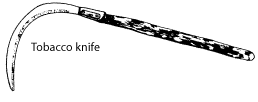
The tobacco knife blade is tough alloy steel that is
12 inches
long by
1
inch wide and 3/32-inch thick.
It is beveled and sharpened with an
ax stone
only
on one side. The round hardwood handle
is 1¼ inches in
diameter.
Scythes efficiently mow open areas of weeds or grass. Grass or weed scythes have 24- to 40-inch blades and long handles. Brush scythes have shorter, sturdier blades and handles and are often preferred by trail crews.
Operate the scythe by grasping the handles (nibs) projecting from the bar (snath) and rhythmically sweeping the blade low to the ground across and in front of you. A "grass nail" placed between the bar and the blade keeps vegetation from catching in that junction.
Carry scythes by your side in one hand, blade forward and handle behind. Keep control of the blade by grasping the handle near the blade and pointing the blade away from your body with the tip down. Stop and change hands if the tool becomes too heavy. Transport scythes well behind a line of workers, and work only in areas clear of others.
Before sharpening the scythe, stand the handle on its end so the blade is horizontal and the tip points down. Use a whetstone or scythestone to hone the blade from back to front (tang to tip) on both sides. Maintain the factory edge bevel. If the blade is badly chipped detach it from the handle and reshape it with a grinder or file. Return the edge to a bevel of 10°. Although some argue that the wire edge facilitates cutting light vegetation, we recommend removing it. A lesser known method of sharpening involves beating the blade with a special hammer to shape and sharpen it without grinding. Finish with a whetstone.
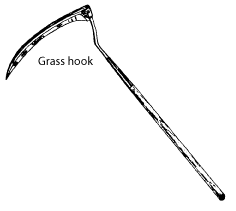

Sickles are curved knives used to cut weeds or grass in limited space. The single grip handle angles upward so the blade cuts parallel to the ground while the operator stands bent at the waist. The blade is 12 inches long and the handle is 4 to 5 inches long.
Carry the sickle by your side with the cutting edge away from your body and pointed down. Maintain a firm grip on the handle when carrying or using.
Maintain sickles with a whetstone or scythestone. The blade is beveled on the top side only. Remove the wire edge by working the stone flat against the backside.
The grass hook combines features of scythes and sickles. It can be operated like a scythe from an upright position, but the small blade is maintained like a sickle.
Workers can easily trim annual vegetation along a trail with a weed hook. These tools have a curved inside blade that cuts by pulling through stems toward the operator and a straight top blade that cuts by pushing. Long handles allow the operator to remain upright.
Since these tools are light enough to operate with a single grip, carry them by the handle with the head away from the body and down and weed as you walk. Always maintain safe distances between workers. Remember that the tool has two cutting edges and that swinging it could be especially hazardous. Sharpen weed hooks with a mill bastard file and finish with a whetstone. Use a curving stroke on the pulling cutter that follows the inside edge around to the tip. Sharpen the pushing cutter on the top side only.
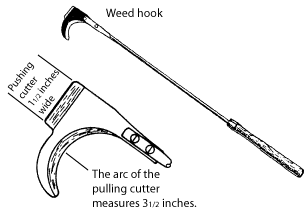
Weed hook and head diagram.
Weed cutters are used for cutting light growth like grasses and annuals that grow along trails. They are lightweight and durable and usually swung like a golf club. The sharper the blade, the less energy needed to cut. Both edges are serrated and cut on the forward and return strokes. When sharpening the edges of these tools, remember that different models have the blade bevels on different sides. The frame may interfere when sharpening top-beveled blades. It may be best to remove the blade and screw it to a block of wood for sharpening. Maintain a 25° bevel on both serrated and straight blades. Cutters usually have a 9- by 2-inch blade and a 40-inch long handle.



